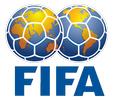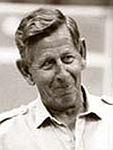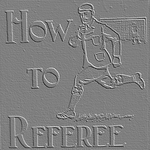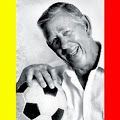 This Video from the... Ken Aston Referee Society -
This Video from the... Ken Aston Referee Society -
 Channel Channel

The Throw-In
A throw-in is a method of restarting play.
A goal cannot be scored directly from a throw-in.
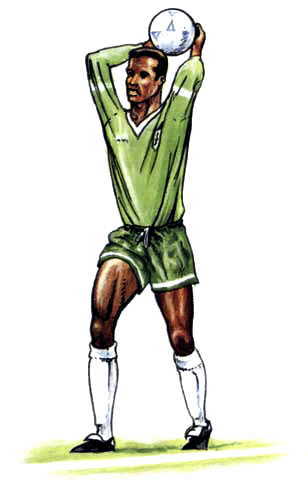
A throw-in is awarded:
 - When the whole of the ball passes over the touch line, either on the
ground or in the air from the point where it crossed the touch line to
the opponents of the player who last touched the ball
- When the whole of the ball passes over the touch line, either on the
ground or in the air from the point where it crossed the touch line to
the opponents of the player who last touched the ball
Procedure
At the moment of delivering the
ball, the thrower:
 - Faces the field of play
- Faces the field of play
 - Has part of each foot either on the touch
- Has part of each foot either on the touch
 - Line or on the ground outside the touch line
- Line or on the ground outside the touch line
 - Uses both hands
- Uses both hands
 - Delivers the ball from behind and over his head
- Delivers the ball from behind and over his head
The thrower may not touch the ball
again until it has touched another player:
 - The ball is in play immediately it enters the field of play.
- The ball is in play immediately it enters the field of play.
Infringements/Sanctions
Throw-in taken by a player other than the goalkeeper
If, after the ball
is in play, the thrower touches the ball a second time (except with his
hands) before it has touched another player:
 -
An indirect free kick is awarded to the opposing team, the kick to be
taken from the place where the infringement occurred
-
An indirect free kick is awarded to the opposing team, the kick to be
taken from the place where the infringement occurred
If, after the ball is in play, the thrower deliberately handles the ball
before it has touched another player:
 -
A direct free kick is awarded to the opposing team, the kick to be taken
from the place where the infringement occurred
-
A direct free kick is awarded to the opposing team, the kick to be taken
from the place where the infringement occurred
 -
A penalty kick is awarded if the infringement occurred inside the
thrower's penalty area
-
A penalty kick is awarded if the infringement occurred inside the
thrower's penalty area
Throw-in taken by the goalkeeper If, after the ball is in play, the
goalkeeper touches the ball a second time (except with his hands),
before it has touched another player:
 -
An indirect free kick is awarded to the opposing team, the kick to be
taken from the place where the infringement occurred
-
An indirect free kick is awarded to the opposing team, the kick to be
taken from the place where the infringement occurred
If, after the ball is in play, the goalkeeper deliberately handles the
ball before it has touched another player:
 -
A direct free kick is awarded to the opposing team if the infringement
occurred outside the goalkeeper's penalty area, the kick to be taken
from the place where the infringement occurred
-
A direct free kick is awarded to the opposing team if the infringement
occurred outside the goalkeeper's penalty area, the kick to be taken
from the place where the infringement occurred
 -
An indirect free kick is awarded to the opposing team if the
infringement occurred inside the goalkeeper's penalty area, the kick to
be taken from the place where the infringement occurred
-
An indirect free kick is awarded to the opposing team if the
infringement occurred inside the goalkeeper's penalty area, the kick to
be taken from the place where the infringement occurred
If an opponent unfairly distracts or impedes the thrower:
 -
He is cautioned for unsporting behavior and shown the yellow card
-
He is cautioned for unsporting behavior and shown the yellow card
For any other infringement of this Law:
 -
The throw-in is taken by a player of the opposing team
-
The throw-in is taken by a player of the opposing team
To recognize a correct
throw-in and how to deal with any infringements.
1. The Throw-In:
2. The Procedure:
3. Action required by Referee/ Assistant Referee:
4. Infringements:
5. Throw-in taken by other than the Goalkeeper:
6. Throw-in taken by the Goalkeeper:
7. General data:
8. Referee's Position During Throw-ins:
9. Questions & Answers: |
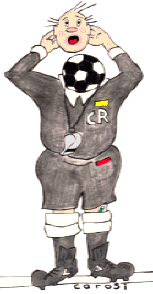 |
1. The Throw-In:
(Is a method of restarting play).
Is awarded when the WHOLE of the ball crosses the touchline, on the
ground or in the air.
Is awarded to the opponents of the player who last touched the ball
before it crossed the touchline.
Ball is in play as soon as it crosses the touchline and comes back into
the Field of Play.
2. The Procedure:
The ball must be thrown from the point where it crossed the line.
The thrower should ideally be no more than 1 yard back from the
touchline.
The thrower must face the field of play.
The thrower must use two hands in a continuous motion. Beware the
thrower using the strength of one arm/hand to propel the ball, this is
illegal. The ball must not be dropped.
Part of each foot must be on the touchline
or on the ground outside the touchline.
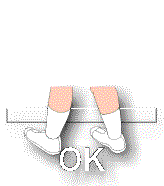 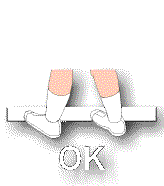 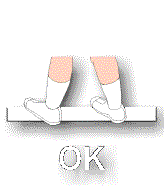 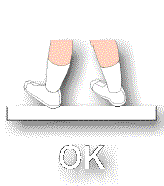 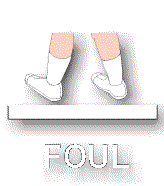
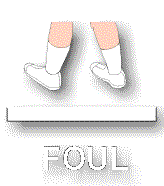 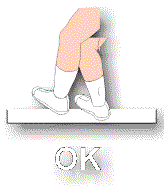 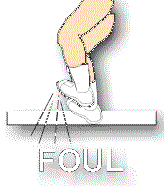 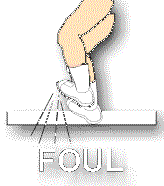 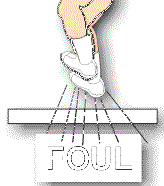
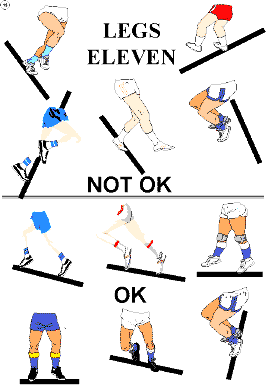
The thrower must deliver the ball from behind and over their head in a
continuous motion. This does not mean that the ball must leave the hands
from an overhead position. A natural throwing movement starting from
behind and over the head will usually result in the ball leaving the
hands when they are in front of the vertical plane of the body. The
throwing movement must be continued to the point of release.
(Source England Football Association Memorandum)
Referees very often penalize a thrower, if the ball is released in front
of the vertical plane of the thrower's body, but this is still a legal
throw - so long as the arm movement is continuous before the ball is
released. And the ball was delivered from behind and over the thrower's
head.
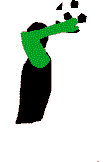 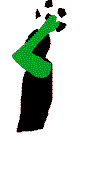  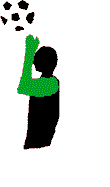 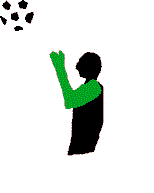 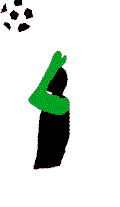
    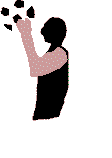 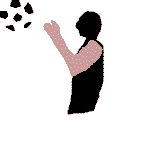
 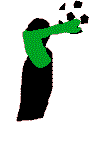  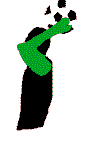 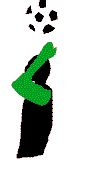
3. Action required by Referee/ Assistant
Referee:
When the ball goes out of play for a throw-in, the Assistant Referee
and/or the Referee should indicate the direction of the throw-in. If you
are not sure of the direction to award the throw-in, you can consider
giving it to the defending team.
IF IN DOUBT WHICH WAY TO GIVE A THROW IN - BE VERY POSITIVE AN JUST
DECIDE A DIRECTION
...........BE STRONG AND ADAMANT

THIS IS PROBABLY THE BEST BIT OF ADVICE YOU WILL GET ON THROW-INS.
PLAYERS CAN GET VERY IRATE AT WEAK REFEREE THROW-IN DECISIONS
The Referee (or the Assistant Referee) should indicate where the
throw-in should be taken, and which direction it should be taken.
Players will normally look to the Referee (or to the Assistant Referee)
to indicate direction.
If a Referee disagrees with the Assistant Referee or club linesman, on
the direction to award a throw-in, the Referee must have the final say.
The Assistant Referee or club linesman must then redirect their flag
signal immediately to correspond to the direction given by the Referee.
The Referee can ask the Assistant Referees, to watch feet faults whilst
the Referee watches hand movement faults.
Position of Referee during a throw-in: You need to have a clear view -
but do not get too near. You can stray from your diagonal towards the
throw.
Keep both the thrower & the Assistant Referee/club linesman on the far
side in view.
Assistant Referees position: Near but not impeding the thrower: Goal
side on the touchline looking for any off sides.
Whistling for throw-ins: There is no need to always blow your whistle to
award/indicate a throw-in, but you will need to do so on some occasions.
Especially when some players do not realize (or believe) that the ball
has gone out of play over the touchline.
4.
Infringements:
If the ball is not thrown-in correctly, then a throw-in must be awarded
to the other side. (Common infringements include dropping the ball to a
close colleague instead of throwing it, taking throw-in from the wrong
place, lifting one leg.)
Throwing the ball onto the back of a
colleague or an opponent = award throw-in to other side
~ Unsporting
behavior ~
5. Throw-in taken by other than the
Goalkeeper:
A player may not touch the ball a second time until it has touched
another player.
 -
If the thrower touches the ball a second time (except with his hands):
INDIRECT FREE KICK TO OPPONENTS FROM PLACE OF INFRINGEMENT
-
If the thrower touches the ball a second time (except with his hands):
INDIRECT FREE KICK TO OPPONENTS FROM PLACE OF INFRINGEMENT
 -
If player touches the ball a second time with his hands:
DIRECT FREE
KICK FROM PLACE OF INFRINGEMENT. PENALTY IF HE TOUCHES WITHIN HIS OWN
PENALTY AREA
-
If player touches the ball a second time with his hands:
DIRECT FREE
KICK FROM PLACE OF INFRINGEMENT. PENALTY IF HE TOUCHES WITHIN HIS OWN
PENALTY AREA
6. Throw-in taken by the Goalkeeper:
The goalkeeper may not touch the ball a second time until it has touched
another player.
 -
If the goalkeeper touches the ball a second time (except with his
hands):
-
If the goalkeeper touches the ball a second time (except with his
hands):
~ INDIRECT FREE KICK TO OPPONENTS FROM PLACE OF INFRINGEMENT
 -
If goalkeeper touches the ball a second time with his hands:
-
If goalkeeper touches the ball a second time with his hands:
~ DIRECT FREE KICK FROM PLACE OF INFRINGEMENT IF OUTSIDE THE
GOALKEEPER'S PENALTY AREA
~ INDIRECT FREE KICK IF INSIDE THE GOALKEEPER'S PENALTY AREA
7. General data:
If an opponent unfairly distracts or impedes a thrower, i.e. by jumping
up and down in front of the thrower: CAUTION FOR UNSPORTING BEHAVIOUR.
If the goalkeeper touches the ball in his penalty area with his hands
after he has received it directly from a throw-in taken by a teammate:
 - = INDIRECT FREE-KICK FROM PLACE OF
INFRINGEMENT
- = INDIRECT FREE-KICK FROM PLACE OF
INFRINGEMENT
 - = DIRECT FREE-KICK IF OUTSIDE OF HIS OWN
PENALTY AREA (Remember - once the goalkeeper leaves his penalty
area - he becomes another outfield player).
- = DIRECT FREE-KICK IF OUTSIDE OF HIS OWN
PENALTY AREA (Remember - once the goalkeeper leaves his penalty
area - he becomes another outfield player).
For any other infringements - THROW-IN TO BE TAKEN BY OPPOSING TEAM
(i.e. if the throw-in was taken from wrong place).
If the ball is thrown into play - arches into play and then goes back
out over the touch line without being touched by another player: =
THROW IN TO OPPONENTS.
If a player is time wasting: CAUTION FOR
UNSPORTING BEHAVIOUR. And then let same team take throw-in. You
award a throw-in to
the opposing side after cautioning a player for time wasting - because
the ball has not re-entered back into play.
A goal cannot be scored directly from any throw-in.
If a ball is thrown directly into an opponents' goal: =
GOAL KICK.
As soon as the ball crosses the touchline, it is in deemed in active
normal play.
If a ball is thrown directly into a player’s own goal: =
CORNER KICK.
A ball can be thrown to a player in an offside position. That player is
then not deemed offside once he receives the ball.
8. Referee's Position During Throw-Ins
Figures 1 and 2 below show the optimum position for a Referee to stand
(alongside, or near to his Referee's diagonal - RD) during the taking of
throw-ins.
An attacking team taking a throw-in, within their opponents’ half of the
field of play, already has possession of the ball, and is more likely to
retain it, than losing possession to the defending team. Therefore,
during the taking of a throw-in by the attacking team (in the attacking
- shaded - half of the field of play) the Referee should try and
position himself so that he has a panoramic view of the play action (the
area where the thrower is standing, and the anticipated area that the
ball will be thrown into) between himself and his Assistant Referee. The
Referee should put more onuses on anticipating a successful attacking
move. An attacking move in this area of the field of play can develop
quickly, so the Referee needs to ensure that he is in such a position to
allow himself a good view of the anticipated attacking play area. The
Referee can do this by standing slightly nearer to the halfway line than
the thrower - thus keeping the play action between himself and his
Assistant Referee. The only exception to this, is when the attacking
team throw-in is being taken very near the defending team's corner flag
at the end of the Referee's diagonal - the optimum position for
the Referee here, is alongside the goal line . This allows the Referee
to have an unobstructed view of the goal area and the play action areas.
Referees will need to sprint to this position quickly before a throw-in
is taken. This can sometimes be difficult for the Referee to achieve in
a fast flowing game. If the Referee is unable to reach this corner
flag/goal line position before the throw-in is taken - he should
position himself.
A defensive team taking a throw-in, within their own half of the field
of play, already has possession of the ball, and is more likely to
retain it, than losing possession to the attacking team. Therefore, the
Referee should put more onuses on anticipating a successful defensive
move. A defending move in this area of the field of play can develop
quickly, so the Referee needs to ensure that he is in such a position to
allow himself a good view of the anticipated defensive play area, and to
be able to move quickly into the other half of the field of play as play
develops. The Referee can do this by standing slightly nearer to the
halfway line than the defending team's thrower - thus keeping the play
action between himself and his Assistant Referee. This allows the
Referee to have an unobstructed view of all the play action areas. The
Referee would not be expected to position himself near the corner flag
or on the goal line when a throw-in is taken by the defensive team in
their own half of the field of play by the corner flags.
Although the Referee should aim to keep as near to his diagonal as
possible, he can deviate from his diagonal, to lessen the distance
between himself and the thrower, especially if he anticipates any
trouble areas between players. The Referee will also very often move
away from his diagonal and towards the thrower, when the throw-in is
taken near the opposite corner flag to his diagonal in both halves of
the field of play.
Before an attacking team takes a throw-in at the halfway line, the
Referee who should be positioned on or near the halfway line should
always look over towards his Assistant Referee (the one who is looking
out for the attacking team offside) and locate his position. This
locating of the Assistant Referee allows the Referee a fraction of a
second, in knowing exactly where to look to identify if an offside flag
quickly follows the play action after a throw-in has been taken. It also
develops the Referee/Assistant Referees' eye contact team bonding
building spirit, and lets the Assistant Referee know "that the Referee
is aware of, and is acknowledging and encouraging his team's
participation".
When Club Linesmen are involved, the Referee will normally need to take
full responsibility for conducting throw-ins taken in all the field of
play areas.
Anticipating play action following a throw-in will enable the Referee to
adjust his position and lessen the distance he has to run to catch up
with the following throw-in play action. Each game is different, and
each player is capable of differing standards - so the Referee will need
to adjust his position according to a number of differing factors in
every game. The details below enable Referees (new Referees in
particular) to understand the importance of positioning during a game.
It can be very frustrating for new Referees when they see experienced
Referee colleagues almost strolling around during a match - whilst they
themselves seem to have to sprint to all their positions during their
early games. It's all down to anticipation and correct positioning - and
of course experience.
+-+ BACK TO TOP +-+
+-+ FIFA-ADDITIONAL +-+
+-+ ADVICE from 'THE PITCH' +-+
Questions and Answers:
This web site and the advice and answers to any questions are not
sanctioned by or affiliated with any governing body of soccer. The
opinions expressed on this site should not be considered official
interpretations of the Laws of the Game. Although the content of the
latest Laws are included on this site, the majority of the content is
the opinion of the Webmaster and other Referees worldwide. If you need
an official ruling you should contact your local representative/association
or visit the FIFA, or the English FA web sites for the Laws themselves.
Questions and Answers:
Question 1: Following a
challenge for the ball between an attacker and a defender near the
touchline, the ball was seen to squirm off the players and deflects over
the touchline and out of play. It looked as though both of the players
were taking a kick at the ball at the same time whilst making the
challenge, and at first, it appears as though the defender may have made
the last contact with the ball a fraction of a second after the
attacker, but from a distance it looked as though they both made contact
with the ball at the same time, causing it to deflect over the
touchline. It can sometimes be impossible to decide which way to award a
throw-in - especially when there are a number of players around the
ball, and it is touched quickly in succession by a number of players
before crossing the touchline. Is there any advice you can give in such
situations? .
Answer 1: It all depends on the
Referees perception, and (for want of a better term) his Default
Automatic Method Navigator (D.A.M.N.) because you're damned if you do,
and you're damned if you don't!). The same applies to free kicks and
corner/goal kicks. These unclear types of decisions are probably the
easiest to make, even though they are the most difficult to make. This
may seem like a contradiction - but let me explain. Firstly, the Referee
must recognize that there will be many times during each match, when it
is impossible to make the correct decision. This is due to a number of
factors. The speed of play, the distance between the incident and the
Referee, the fitness of the Referee, whether there are players in the
Referee's line of sight, the shielding of the ball by the players' - and
dare I say it "the Referee's eyesight"!
In unclear decision situations of this type, the Referee can give the
decision to the attacking team or he can give it to the defending team.
Some Referees automatically give 'unsure' decisions to the defending
team - this is how it has been done historically in the past. Some
modern Referees give 'unsure' decisions to the attacking team, thus
embodying a modern movement to give the attacking team the advantage,
therefore increasing the chances of a goal being scored - which in turn
will increase the enjoyment of the spectators.
(a), during an
offside situation, if a Referee or an Assistant Referee is unsure
whether an attacker is level or not with the second last defender, then
the benefit of the doubt normally goes to the attacker - and play is
allowed to continue.
(b), when a ball is
deflected over the touchline and the Referee does not know which side to
award the throw-in to, it is normally given to the defending team.)
New Referees are advised to chose one of the two D.A.M.N. methods to use
when being unsure of which way to give a decision (give it to the
defending team? or give it to the attacking team? - but be consistent).
Of course, the above advice also applies (more so) to the Assistant
Referee.
So the answer to the question above is?..... There is no answer; it's up
to you the Referee!

The Referee should not 'lose any sleep' worrying about whether he has
made the correct decision or not during a game. Even if the Referee (or
Assistant Referee) makes the wrong decision - it is the right decision
as far as the match is concerned, because he is the only one responsible
(some decisions you win and some you lose). Match incidents happen in
split seconds, and Referees' have to make instant decisions and continue
onwards with the game. If a Referee shows any weakness or uncertainty
when making delayed or unsure decisions, the players, the crowd and the
team officials will certainly make the most of it! Be firm and positive
and accept that you will make genuine honest mistakes - but accept that
they are not made by you (the Referee) on purpose.
Question 2: If during a match the ball goes out of play over the
touchline in the air and is then blown back into the field of play
before touching the ground is the ball still in play?
Answer 2: No. The touchline extends in an upward plane into the air. If
the whole ball crosses this upward plane it is out of play. If the ball
is subsequently blown back, a throw in should be awarded against the
team who last touched the ball. The throw-in should be taken on the
touchline, from the point that the ball crossed the upward plane of the
touchline. Referees should not be too particular about the throw-in
being taken on the exact blade of grass where the ball went out of play
- so long as an honest attempt at estimating the spot is made.
Question 3: What is the correct procedure for taking a throw-in?
Answer 3: When the ball is delivered (released) by the thrower, he
should be facing the field of play - this normally means that he also
faces the direction in which he is going to throw the ball. He must have
part of each foot either on the touchline, or on the ground outside of
the touchline. The thrower is allowed to have a part of his feet inside
the field of play, so long as part of both feet are either touching the
touchline or outside of it. For example: if a thrower has both heels on
the touchline, and his toes extend into the field of play, then this is
OK, and the throw-in should be allowed to take place. Both feet must be
on the ground as the thrower delivers the ball from his hands. He must
use both hands with "equal force". The thrower must deliver the ball
from behind and over their head in a continuous motion. This does not
mean that the ball must leave the hands from an overhead position. A
natural throwing movement starting from behind and over the head will
usually result in the ball leaving the hands when they are in front of
the vertical plane of the body. The throwing movement must be continued
to the point of release.
Referees very often penalize a thrower, if the ball is released in front
of the vertical plane of the thrower's body, but this is still a legal
throw - so long as the arm movement is continuous before the ball is
released. And the ball was delivered from behind and over the thrower's
head.
The sketch below has been used to depict a correct throw-in FA Booklets
for the last 50+ years.
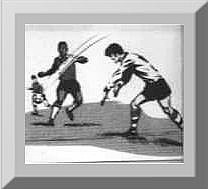
If the ball is 'dropped' without the hands first having passed over the
top of the thrower's head, then this is a foul throw. If this happens,
play should be stopped and the throw awarded to the opposing team. Law
15 states that the ball must be released from behind and over the
thrower's head. A natural throwing movement starting from behind and
over the head will usually result in the ball being released when the
hands are in front of the vertical plane of the body - just in front of
the forehead - this is OK
Referees are advised not to be too 'fussy' about whether throw-ins have
been taken 100% correctly. By all means, penalize any obvious
infringements - but constantly blowing for foul throws is one of the
quickest ways to spoil a game and to get the players 'on your back'.
During competitive matches, (or during games where very young children
are involved) trifling or doubtful technical infringements of Law 15 are
often ignored, so long as no advantage is obtained by the team taking
the throw-in and the throw-in occurs with little or no delay.
Although spinning the ball is allowed, players who unduly spin the ball
when it is released, indicates that it has been thrown-in with unequal
hand strength. There are some players who use their strongest hand/arm
to propel the ball into the field of play, and this puts more power into
the throw. If this happens, the player should be penalized, and the
throw-in awarded to the opposition. The ball must be thrown-in with
equal pressure from both of the player's hands.
Question 4: Just how close to the spot where the ball actually crossed
the touchline does the thrower have to be before he is allowed to take a
throw-in?
Answer 4: Referees generally allow some leeway in relation to where the
ball actually crossed the touchline. Law 15 states that the throw-in
should be taken from the point where the ball crossed over the touchline
- but in reality, throw-ins are rarely taken from the correct spot. The
Referee normally overlooks a margin of a few meters (yards) or so either
way. Do not allow players to abuse this allowance. The best way to deal
with players moving too far away from the correct position is for the
Referee to blow their whistle before the throw has taken place, and wave
players back nearer to the correct position. Prevention is far better
than cure - and this is just one instance where a good Referee can
prevent infringements happening during a match. A little bit of
foresight by the Referee can prevent untold problems arising. The
Referee should always try to educate players where he can - this will
prevent further problems arising in the game; and the players will learn
how to take the throw correctly (they will also appreciate that you -
the Referee - are also taking an interest in the game, and are not there
just to hand out yellow and red cards!).
When the ball has been kicked high over the touchline, players and
Referees generally operate on a "feel" for the correct place for a
throw-in to be taken. It is impossible for a Referee to gauge the
correct throw-in position when the ball is lofted some 30 meters high at
and at an angle over the touchline, and the Referee is still in the
center circle. The Referee should make a 'best guess' for the correct
position. Players will look towards the Referee to give them some
indication of where the throw-in should be taken. In instances of this
nature, the Referee should not wait for the players to ask him - the
Referee should indicate where the throw-in should be taken.
The Referee can do this by several methods.
 -
(a) By blowing his whistle, using short
peeps and hand movements to entice players back into the correct
position.
-
(a) By blowing his whistle, using short
peeps and hand movements to entice players back into the correct
position.
 -
(b) By speaking to players and telling them to move up or down
accordingly.
-
(b) By speaking to players and telling them to move up or down
accordingly.
 -
(c) By hand signals alone - the Referee can 'shoo' players
up or down the touchline by waving his hands in the appropriate
direction.
-
(c) By hand signals alone - the Referee can 'shoo' players
up or down the touchline by waving his hands in the appropriate
direction.
Assistant Referees should also speak to players, and coax
them to take the throw-in as near to the correct position as practical.
It is important for Referees to ensure that players taking throw-ins, do
not gain an unfair advantage by advancing or retreating along the
touchline.
Referees are also advised to penalize players who take throw-ins many
meters back from the touchline. Players are very cunning - for example,
when they retrieve the ball for a throw-in and are making their way back
to the touchline, they very often throw the ball in at an angle, whilst
they are 10 or more meters away from the touchline, the ball then enters
the field of play some 20 yards from where it crossed out of play over
the touchline. This is a foul throw and should not be allowed. The
throw-in should be awarded to the opposing team. The ball must enter the
field from the point where it crossed the touchline.
Question 5: During the taking of a throw-in, it was noticed that the
Referee allowed the player take it about four yards from the spot where
the ball went out over the touchline. Later on in the game, the Referee
was seen to be very particular about players taking throw-ins from the
exact place where the ball had left the field of play. Why are Referees
so inconsistent?
Answer 5: Most Referees allow some latitude on the exact positioning of
throw-ins. Especially if the location is away from the goals, and near
the middle of the field. This allows the ball to be thrown back into
play as quickly as possible. Players are usually receptive to this type
of common sense, and are less interested in adhering strictly to the Law
about exact positioning. Players do not often argue over such action,
this demonstrates a good sportsmanship that will normally have little or
no effect on the result of the match.
If the throw-in, is in such a position that could affect the outcome of
a game (for instance, if a team has a good thrower, and the throw is
towards the corner arc), the Referee should ensure that the thrower does
not gain an advantage by moving too far along the touchline to be nearer
to the goal. Some Referees are more particular about making players take
the throw from the correct position every time - but in my experience,
this (along with the finicky positioning of free kicks) is the easiest
way for a Referee to frustrate players and spoil a match.
Question 6: What should the Referee look for when players are deciding
amongst themselves who should take a throw-in?
Answer 6: There will be many occasions during a match when players pass
the ball to each other, or wait for colleagues to catch up with play
before a throw-in is taken. The Referee must decide whether players are
taking such actions solely to waste time. Players purposefully wasting
time should be cautioned and time added on at the end of the game to
compensate for any lost time. For example, if the ball goes out of play
for a throw-in and an attacking right wing player picks up the ball near
the halfway flag to throw in and then he decides to wait for his left
fullback to slowly make their way across the width of the field to take
the throw-in - then this is obviously time-wasting - and a yellow card
should be given. Players very often retrieve the ball and then pass it
to a teammate to make the throw-in instead. This is done for tactical
reasons, or to allow a better thrower to project the ball further into
play from the throw-in. The Referee should ensure that the player coming
to take the throw-in, actually steps off of the field of play before he
takes-over the throw-in. The Referee needs to differentiate between a
player taking a throw-in, and a player simply tossing the ball to
college for them to take the throw instead - it is usually obvious which
is which.
Question 7: During a match where I was the Referee, a defending player
taking a throw-in near his penalty area, lifted one of his feet from the
ground as he took the throw. It was an obvious foul throw - but because
the ball went directly to an opponent, I decided (in my mind) to play
advantage. The attacking player turned with the ball and 'blasted' it
straight into the defending team's goal. I awarded the goal. I was
momentarily confused. Should I allow the goal, or should I insist that
the throw-in must be re-taken by the attacking team because a foul throw
had taken place. As there was only 5 minutes of the match remaining, and
the score was Attackers 8 Defenders 0, I decided to allow the goal to
count. Did I make the correct decision?
Answer 7: No. Under no circumstances should advantage be applied to a
throw-in performed illegally. In this instance, the throw-in was a foul
throw-in and should have been awarded to the thrower's opponents. The
goal should not have counted.
I must make a confession here - I (the webmaster) was the Referee in the
above question. I had been refereeing many years, and had never
encountered this situation before. At the time, I knew in my mind that
the correct decision should have been to stop play immediately and award
the throw-in to the attacking team - but because of the circumstances,
and because none of the players shouted "foul throw" (as is their normal
wont), it fleetingly crossed my mind that it was not worth stopping the
game at that particular time. I was wrong - and even though I 'sort of
knew' I was wrong at the time - I still allowed the goal to count. The
moral of this question? Where the Laws are 'black and white' the Referee
should adhere to them at all times. I learnt from my mistake, and it
will never happen again. It did 'prick' my conscience for a day or two,
but luckily the match was a pre-season friendly, so the extra 'bonus'
goal did not make too much difference. There will be many times during a
Referee's career, that he will make some very strange decisions against
everything he has been taught - but let us not forget, we are just as
human as the players and they certainly make many more mistakes during a
match.
Question 8: Is it legal for players to perform an acrobatic somersault
as they run up towards the touchline, and then release the ball during a
throw-in?
Answer 8: Yes, provided that the correct procedures have been followed.
As long as the throw meets all the criteria in Law 15 (correct position,
ball delivered from behind and over the head, with two hands while
facing the field of play, feet in the right position and on the ground
when the ball is released, etc.) then the throw is legal. In England
during the 1980's, this type of throw was the vogue and was performed
many times - but suddenly stopped for no reason at all? I suppose
spectators got fed up and the novelty ran out!
Question 9: Are players allowed to take a throw-in whilst they are
kneeling down, or sitting down?
Answer 9: Players are not allowed to take a throw-in whilst they are
kneeling or sitting down.
Question 10: What is the correct restart when a player taking a
throw-in, throws the ball directly into his own goal without any other
player touching the ball on its route into goal?
Answer 10: A goal cannot be scored directly from a throw-in. The correct
restart when a player throws the ball directly into his own goal -is a
corner kick to the opposing team.
Question 11: What is the correct restart when a player taking a
throw-in, throws the ball directly into his opponent's goal without any
other player touching the ball on its route to goal?
Answer 11: A goal cannot be scored directly from a throw-in. The correct
restart when a player throws the ball directly into his opponent's goal
- is a goal kick to the opposing team.
Question 12: Are players who take throw-ins allowed to throw the ball
onto the back of an unsuspecting colleague or opponent, and then regain
possession of the ball themselves? Law 15 states that the player taking
a throw-in is not allowed touching the ball again, until another player
has touched it - and in this case it had?
Answer 12: In this instance, another player had touched the ball, so by
Law, play should be allowed to continue. But wait a minute - this is
certainly against the 'spirit of the game'. The thrower had used
trickery to circumvent the criteria laid down in Law 15. The thrower
should definitely be penalized for his unsporting action. Law 15 states
that for any other infringement not mentioned in Law 15, the throw-in
should be re-taken by a player from the opposing team. In this instance,
play should be stopped, and the throw-in awarded to the opposing team.
The Referee can also consider cautioning the unsporting player.
Question 13: During a fiercely contested match, the ball travels out for
a throw-in to the attacking team. An attacker proceeds to take the
throw-in, but as he approaches the touchline, a defender purposefully
stands 1 meter away from the touchline immediately in front of the
oncoming thrower. The thrower continues with his run-up, and throws the
ball in correctly, but purposefully straight into the defenders face.
What action should the Referee take?
Answer 13: Send the attacking thrower off for violent conduct. The
defender is entitled to stand in front of the attacking thrower - so
long as the defender does not jump up and down or wave his arms about,
he is entitled to stand where he likes on the field of play. The action
of the attacking thrower (although not infringing any of the Law 15
Throw-in criteria) was purposefully done to inflict damage to his
opponent. Because the ball had entered into play from the throw-in, the
correct restart is to award a direct free kick to the defending team
from the place where the offence occurred, i.e. the place where the ball
struck the defender in the face.
The fact that the ball strikes an opponent following the taking of a
throw-in is not in itself an infringement of the Laws. The Referee must
decide if the action (and the force in which the ball is propelled into
an opponent) warrants a red or a yellow card. In most cases when this
action is done deliberately, it should be a red card.
If a player purposefully dances up and down, gesticulates or waves his
arms in front of a player taking a throw-in, then he should be cautioned
for unsporting behavior. Such action is not allowed, and is against the
'spirit of the game'. Referees should anticipate such action, and warn
any approaching players to behave themselves. Players are not allowed to
block the freedom of movement of the thrower or to harass him, or to
move into a position to block a throw in a particular direction. But
they are allowed to stand still on the field of play in front of the
thrower.
Question 14: If the ball fails to enter the field of play during a
throw-in, what action should the Referee take?
Answer 14: The Referee should ask the thrower to re-take the throw-in.
The ball is not in play until it enters the field of play. Under no
circumstances should the throw-in be awarded to the opposing team. As
play had not restarted (because the ball had not entered the field of
play on the first throw-in, the only legal restart is a retake of the
throw-in by the same side.
Question 15: During a throw-in, the ball enters the field of play,
travels down just inside the field of play alongside the touchline, and
is subsequently blown (by the wind) back over touchline and out of play
again before it has been touched by another player. What is the correct
restart?
Answer 15: The Referee should award a throw-in to the other team, to be
taken from where the ball last left the field of play when it was blown
back out of play over the touchline.
Question 16: During a throw-in, the ball travels along the touchline.
What action should the Referee take?
Answer 16: None. The touchlines are part of the field of play, and the
ball is deemed to be in play from a throw-in, the moment the ball
touches or crosses the touchline. The whole of the ball does not have to
be inside the field of play - so long as a part of the ball is over the
touchline, it is deemed to be in play. A ball thrown along the touchline
itself is deemed to be back in play.
Question 17: If a player taking a throw-in, throws the ball into the
field of play, and then proceeds to kick the ball before it has been
touched by another player - what action should the Referee take?
Answer 17: The thrower is not allowed to touch the ball a second time
until another player has touched it. An indirect free kick should be
awarded to the opposing team, to be taken from the place where the
thrower touched the ball a second time following his throw-in.
Question 18: Is a goalkeeper allowed to take a throw-in?
Answer 18: Once a goalkeeper leaves his penalty area, he becomes another
normal outfield player and is subject to the same rules and permissions
as the other outfield players. There is therefore no reason why the
goalkeeper cannot take a throw-in for his team.
Question 19: Why is it that some Referees are particular about calling
for foul throws when a player lifts his trailing foot off the ground,
and other Referees never seem to bother about this infringement of Law
15?
Answer 19: It can be difficult to ascertain the exact moment when a
player lifts his foot off the ground before releasing the ball. Some
Referees allow a greater leeway in judging that the foot is raised AFTER
the ball is been released. Over the years, throw-in infringements have
become less. This is due both to better coaching, and a better
understanding by Referees in deciding what minor infringements to ignore
during a match.
Question 20: What action should a Referee take if a goalkeeper picks the
ball up after it has been thrown directly to him by a colleague (without
having been touched by another player).
Answer 20: An indirect free kick should be awarded to the other team if
the goalkeeper touches or picks the ball up inside his own penalty area.
A direct free kick should be awarded to the other team, if the
goalkeeper touches or picks the ball up outside of his own penalty area.
In both cases, the free kick should be taken from the spot where the
goalkeeper touched or picked the ball up.
A goalkeeper is allowed to pick the ball up if an opponent throws it to
him.
Question 21: When a goalkeeper receiving the ball direct from a throw-in
taken by a teammate, has to dive and palm the ball away from entering
the goal. - And thus prevents an oncoming nearby attacker from making
contact with the ball and shooting towards goal. Should the Referee Send
off the goalkeeper for denying a goal scoring opportunity and restart
with an indirect free kick, or should the Referee just give the
goalkeeper a caution and restart with an indirect free kick for touching
the ball after it has been received directly from a throw-in taken by a
team mate?
Answer 21: Indirect free kick, no caution, as the goalkeeper is
permitted to handle the ball in his own area.
When a goalkeeper handles the ball whilst in his own penalty area, in
violation of the laws, the punishment is an indirect free kick and not a
penalty kick (for example, when he handles the ball after receiving it
directly from a colleague taking a throw-in).
Because a goalkeeper is allowed to handle the ball in his own penalty
area, he cannot therefore be sent off for stopping an obvious goal
scoring opportunity by illegal use of his hands in his own penalty area.
(The goalkeeper can of course be sent off for stopping an obvious goal
scoring opportunity by other fouls, or if he stops an obvious goal
scoring opportunity by handling the ball outside of his penalty area).
Question 22: Before a throw-in has been taken, a colleague of the
thrower deliberately kicks an opponent. What should the Referee do?
Answer 22: Send the offender off the field for violent conduct and
restart play with the original throw-in.
Question 23: When a player taking a throw-in, stands with part of each
foot on or behind the touchline, or with part of his feet inside the
field of play on the touchline and his heels on the touchline, is this
allowed?
Answer 23: Provided that a part of each foot is on or behind the
touchline and on the ground, the throw-in is legal.
Question 24: A defender throws the ball towards his goalkeeper. The ball
is just about to enter the goal, and the goalkeeper attempts to stop the
ball with his hands. The goalkeeper dives towards the ball and touches
it with his hands, but the ball carries on into the goal - surely the
Referee must award the attacking team an indirect free kick because the
goalkeeper touched the ball after it was thrown to him from a colleague
- or does the goal count?
Answer 24: If the ball had entered the goal directly without having
touched another player, then a corner kick is to be awarded to the
attacking team. Because the goalkeeper touched the ball before it
entered the goal, the advantage clause should be applied and the goal
should count.
Question 25: Can a goalkeeper pick the ball up when it is throw-in
directly to him by an opponent? This sometimes happens following an
injury, when the ball had been previously kicked out of play over the
touchline by one of the goalkeeper's colleagues to allow an injured
opponent to be treated.
Answer 25: Yes, the goalkeeper can touch or pick the ball up when it is
thrown directly to him from an opponent taking a throw-in. It is only
when the goalkeeper touches or picks the ball up after it has been
thrown to him by a teammate that an indirect free kick is awarded to the
opposition. This was covered in a Law 12 change in the 1997/98 seasons.
Question 26: If a Referee is the only match official present, and when a
player throws the ball down along the touchline, how can the Referee
decide whether the ball has actually entered the field of play or not?
Answer 26: The Referee should try and position himself to allow as
reasonable view as possible of the area that the throw-in is being
taken. It is not always possible for the Referee to be alongside the
touchline when every throw-in is being taken. If there are no Club
Linesmen or Assistant Referees to help him, then the Referee should make
a 'best guess' on whether or not the ball has come into play or not from
the throw-in. The Referee should not be influenced by shouts from
players or spectators. In some ways, making decisions like this are
actually easier for the Referee - so long as he is firm and positive
when making his decision, and he has psyched himself up before the match
- to not worry about making unclear honest decisions - the decision then
becomes very easy to make. Referees, who are strong with their
decision-making, soon impart to players that they will not tolerate too
much nonsense and dissent - even when they make the wrong decisions (so
long as they are honest mistakes).
Question 27:
A throw-in is taken by an attacking player at the correct
position
(A). The ball travels 50 feet outside of the field of play
before it brushes the outside edge of the touchline at position
(B). The ball then continues to travel in the air along and
touching the vertical plane (edge) of the touchline for another
20 feet to position
(C). There are several calls of "The ball's not in".
What action should the Assistant Referee take if before the ball
eventually touches the ground, it is caught by a:
(a) Defending opponent
(b) Attacking colleague
(c) Defending team coach/manager
(d) Defending substitute
(e) Spectator |
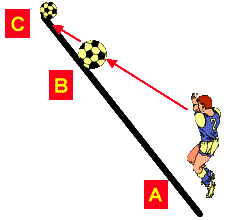 |
Answer 27: Answer: The easiest
way to understand when the ball comes back into play from a throw-in is
to firstly appreciate that the ball goes OUT of play when the whole of
the ball crosses the touchline (Law 15 The Throw-In). Conversely, the
ball shall be in play immediately it enters the field of play when any
part of the ball touches and/or crosses the touchline (either in the air
or on the ground) - so long as the throw-in is taken from the point on
the touchline where the ball left the field of play - and the thrower
does not infringe any of the Law 15 stipulations (e.g. faces the field
of play, uses both hands etc.)
Law 15 clearly states that a throw-in is awarded from the point where it
crossed the touchline. And as such, the ball must enter the field of
play from roughly that exit point (and not some 50 feet down the
touchline).
As far as the question is concerned, the throw-in was improperly taken
because ball entered the field of play some 50 feet from where it
originally went out.
To take matters to the extreme, it would be totally unjust for a
throw-in taken at one end of the field of play (Position A), to enter at
the far end (position B).
If this was allowed, then the thrower might just as well stand at
position (B) when taking the throw-in! In other words, stand just about
anywhere along the touchline.
The Assistant Referee should therefore raise and wave his flag to
indicate a foul throw. The restart would be for the Referee to award a
throw-in the other way, to the opposing team at position (A).
The following...... answers the original question "What action should
the Assistant Referee take if before the ball touches the ground, it is
caught by?"
() Defending opponent:...
Award a throw-into the defending team.
() Attacking colleague:...
Award a throw-into the defending team.
() Defending team
coach/manager:... Award a throw-into the defending team.
() Defending substitute:...
Award a throw-into the defending team.
() Spectator:... Award a
throw-into the defending team.
As the throw-in was not taken properly, the ball is deemed not to have
legally entered play, and as such the restart is always to award a
throw-in to the opposing team.
The Referee can not award a free kick or a dropped ball, for such an
infringement as this - occurring when a foul throw has been committed -
the ball is therefore still out of play. The restart in such occasions
is the natural restart (e.g. throw-in, goal kick, place kick etc.)
The Referee should also strongly consider having a quiet word
particularly with any guilty Defending team coach/manager or defending
substitute. Concerning the encroachment by the spectator - the Referee
should wait for the spectator to leave the field of play, or arrange for
a Home team official or security staff to deal with any problems.
The question becomes more interesting if following the throw-in, the
ball brushes the touchline 3 feet from the thrower and continues its
trajectory traveling the remaining 67 feet along the outside plane of
the touchline to position (C). The ball has thus entered the field of
play correctly (the Referee/Assistant Referee are allowed to apply a
small amount of leeway in judging the exact legal position where the
ball must re- enter the field of play). In this case, the Assistant
Referee does not indicate a foul throw - and the answers to the question
concerning deliberate handling would then be as follows:
() Defending opponent:...
Award a direct free kick to the attacking team.
() Attacking colleague:...
Award a direct free kick to the defending team.
() Defending team
coach/manager:... Dropped ball for outside interference. (Law 8)
() Defending substitute:...
Dropped ball for outside interference. (Law 8)
() Spectator:... Dropped
ball for outside interference. (Law 8)
(Dropped ball to be taken at the place where the ball was located when
play was stropped).
In each case, the Assistant Referee should raise and wave his flag to
indicate that an offence has been committed following the legal taking
of the throw-in.
Any people obscuring the touchline itself should be moved away to allow
the Assistant Referee a clear view. Communication between the Assistant
Referee and the center Referee will have been discusses during the
pre-match briefing that the Referee gives to both his Assistant
Referees. The Assistant Referee (subject to the decision of the Referee)
is normally the judge when deciding if the ball has left the field of
play or not (see Law 6 The Assistant Referee). The Assistant Referee
should position himself goal-side of the player taking the throw-in.
This way, both off sides and throw-ins can be monitored at the same
time. The Assistant Referee would normally monitor any feet faults
whilst the Referee watches for any faulty throwing motions - but these
factors are dependent on the Referee's pre-match instruction to his
Assistants. When indicating an offence, the Assistant Referee first
notifies this to the Referee by raising and waving his flag. The
direction of the offence can further be communicated by the Assistant
Referee pointing his flag in the direction in which the restart should
be awarded - thus indicating to the Referee which team was the guilty
party! When the Referee is unsure why his Assistant Referee has given a
decision, then the simple thing for him to do is to approach the
Assistant Referee and discuss the reasons and the options.
The Assistant Referee should always aim to be in such a position
alongside his touchline, as to allow him the best view of judging
whether a ball delivered from a throw-in legally enters the field of
play or not. If the ball does go into play, and the Assistant Referee
anticipates any of the above incidents - he is not obliged by Law to
warn-off any persons who are about to deliberately handle the ball.
Nevertheless, it could be argued that Law 18 Common sense dictates that
there may be occasions when a quick "The ball is in play" shout from the
Assistant Referee - along with a hand signal indicating 'Play-on’ may
prevent any misunderstanding. I would not personally advise this course
of action for two reasons.
() By
NOT raising his
flag, the Assistant Referee clearly shows to all, that the throw-in has
been taken correctly; and
() The Assistant Referee
should never indicate 'Play-on'. This shout is the center Referee’s
prerogative. It would be very embarrassing if the Assistant Referee
indicates 'Play-on', and the Referee then stops play!
If the ball legally comes into play by touching the plane of the
touchline, say from a throw- in taken by the attacking team - and a
defending player purposefully shouts "Never in" or "The ball's not in"
for example. This could be construed as a 'cheating' move by the
defender to distract the attacking team. If the Referee thinks that the
shout was done on purpose to prevent or delay an attacker from gaining
fair possession of the ball which is in play, the Referee should award
an indirect free kick to the attacking team at the place where the
infringement occurred i.e. where the cheating shout emanated from - and
caution the shouting defender for unsporting behavior.
(See Law 12 Fouls and Misconduct " An indirect free kick is also awarded
to the opposing team if a player, in the opinion of the Referee commits
any other offence, not previously mentioned in Law 12, for which play is
stopped to caution or dismiss a player. The indirect free kick is taken
from where the offence - shouting - occurred.")
To clarify the maximum
distance that a thrower needs to be from the touchline itself......The
UK Football Association basic syllabus with teaching notes booklet
"Course of Training for Referees" clearly states in the candidates 'MUST
KNOW' section covering Throw-ins...........
"from point where it
crossed the touchline (allow up to 1 meter, including behind touchline."
Many thanks to Richard of Edmonton Canada for his interesting question.
Question No. 28: If I
understand correctly that the whole width of the chalk line is indeed
part of the field of play, why does it seem in Law 15 very confusing and
ambiguous that a player would be allowed to have his feet come in
contact with the line during a throw in?
Answer No. 28: You are correct
- the whole width of the chalk line is indeed part of the field of play.
During throw-ins, the position of the ball and when does it come into
play? Are more important that the position of the feet. The positioning
of the feet is somewhat contradictory, because the thrower is off the
field of play, but when taking the throw-in he is allowed onto the field
of play by partly standing on the touchline. I guess that the idea is
for the thrower not to ‘bodily’ come onto the field of play. IN other
words, he needs to be behind the touchline or on it. Therefore, he can
technically be on the field of play, or off the field of play when
taking the throw. And as you say – this is as clear as mud!
Question 29: Is a player
allowed to stand right in front of an opponent who is taking a throw-in?
Answer 29: Players are entitled
to stand anywhere that they want to on the field of play during the
taking of throw-ins. There is no minimum distance specified in the Laws
that states that a player who is on the field of play must be a certain
distance away from an opponent who is taking a throw-in. In other words,
it is not an offence if the player is standing on the touchline, half a
yard (meter) away or 1 yard (meter) away - there is no such distance
stipulation in the Law. It only becomes an offence if the player
"unfairly distracts or impedes a thrower". For example, by jumping up
and down in front of the thrower, waving his hands to distract the
thrower, or shifting his position to impede the thrower who has taken up
a different position to allow him to take the throw-in from a slightly
different position. A player who impedes or distracts a thrower (this
includes making a facial grimace, or verbal distraction) should be
cautioned for unsporting behavior and shown the yellow card. There is
nothing in the Laws to prevent a player standing right in front of a
thrower - so long as he is standing still. A similar situation occurs
during the taking of corner kicks, when attacking players are allowed to
stand immediately in front of the goalkeeper - offences only occur if
the attacking player then makes a move to block (impede) the goalkeeper.
|
